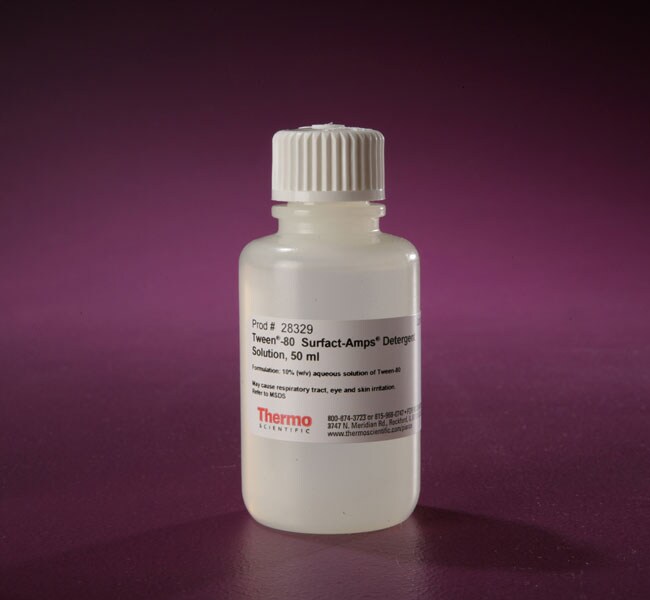Search Thermo Fisher Scientific

Solution de détergent Tween™80 Surfact-Amps™
| Référence | Quantité |
|---|---|
| 28329 | 50 ml |
| 28328 | 6 x 10 mL |
| 28230 | 500 ml |
Caractéristiques de la solution détergente Tween-80 Surfact-Amps :
• Tween 80—un détergent non ionique populaire pour une utilisation en ELISA, transfert Western et autres tampons de lavage PBS ou TBS d’immunoessais
• Précise—solution détergente précise à 10 % dans de l’eau ultra pure
• Facile à utiliser—solution simple à répartir et diluer au cours de l’utilisation
• Exceptionnellement pure—moins de 1,0 µeq/ml de peroxydes et carbonyles
• Stable—conditionnée sous azote dans des ampoules en verre ou flacons PEHD
Propriétés de la solution Tween 80 :
• Poids moléculaire : 1310g
• Classe de détergent : Tensioactif polyoxyéthylène non ionique
• Numéro d’agrégation : 60
• Poids moléculaire micellaire : 76 000g
• Concentration micellaire critique (CMC) : 0,012 mM
• (0,0016 %, p/v) Point de trouble : inconnu
• Dialysable : Non
Caractéristiques de la solution détergente Tween 80 Surfact-Amps :
• Aspect visuel : Solution incolore, légèrement brouillée à trouble, exempte de matières particulaires ; peut former des couches.
• Concentration : 10,0±1,0 %
• d’oxydants : ≤1,0 µeq/ml
• de carbonyles : ≤1,0 µeq/ml
• de solides en suspension : Le résidu présent ne doit pas dépasser les données de référence de résidu.
Produits connexes
Échantillonneur de surfactant™ Surfact-Amps
Figures

Los clientes que vieron este artículo también vieron
Documentation et téléchargements
Certificats
Safety Data Sheets
Foire aux questions (FAQ)
Thermo Scientific Pierce Surfact-Amps detergents are highly purified, precisely diluted (10%) formulations that are ideal for applications or assays that are sensitive to contaminants that are present in unpurified detergents. We test every batch to insure that our detergents contain less than 1.0 µeq/mL peroxides and carbonyls and package them under nitrogen, to prevent oxidization during storage.
Superior quality - lower measurable contaminant levels than other leading vendors
Accurate -precise 10% detergent solution in ultrapure water
Easy-to-use - solution is simple to dispense and dilute for use
Exceptionally pure - less than 1.0 µeq/mL peroxides and carbonyls
Find additional tips, troubleshooting help, and resources within our Protein Purification and Isolation Support Center.
Ionic detergents, or those that carry a charge, are the most likely to be denaturing to proteins. Denaturing detergents can be anionic such as sodium dodecyl sulfate (SDS) or cationic such as ethyl trimethyl ammonium bromide. These detergents totally disrupt membranes and denature proteins by breaking protein-protein interactions through changes in the three-dimensional structure of the proteins. Nondenaturing detergents can be divided into nonionic detergents (i.e., Triton X-100), bile salts (i.e., cholate), and zwitterionic detergents (i.e., CHAPS).
Find additional tips, troubleshooting help, and resources within our Protein Purification and Isolation Support Center.
Detergents are amphipathic molecules containing both a nonpolar “tail” having aliphatic or aromatic character, and a polar “head”. The ionic character of the polar head group forms the basis for broad classification of detergents as ionic, nonionic, or zwitterionic.
Find additional tips, troubleshooting help, and resources within our Protein Purification and Isolation Support Center.
Detergents are amphipathic molecules, meaning they contain both a nonpolar “tail” having aliphatic or aromatic character and a polar “head”. Like the components of biological membranes, detergents have hydrophobic-associating properties as a result of their nonpolar tail groups. Nevertheless, detergents are themselves water soluble.
Consequently, detergent molecules allow the dispersion (miscibility) of water-insoluble, hydrophobic compounds into aqueous media, including the extraction and solubilization of membrane proteins. Detergent monomers solubilize membrane proteins by partitioning into the membrane bilayer. With increasing amounts of detergents, membranes undergo various stages of solubilization.
Find additional tips, troubleshooting help, and resources within our Protein Purification and Isolation Support Center.
Detergents can be denaturing or non-denaturing with respect to protein structure. Denaturing detergents can be anionic such as sodium dodecyl sulfate (SDS) or cationic such as ethyl trimethyl ammonium bromide. These detergents totally disrupt membranes and denature proteins by breaking proteinprotein interaction. These detergents are considered harsh. Non-denaturing detergents can be divided into nonionic detergents (i.e., Triton X-100), bile salts (i.e., cholate), and zwitterionic detergents (i.e., CHAPS). These detergents do not denature proteins and do not break protein-protein interactions. These detergents are considered mild.
Find additional tips, troubleshooting help, and resources within our Protein Purification and Isolation Support Center.